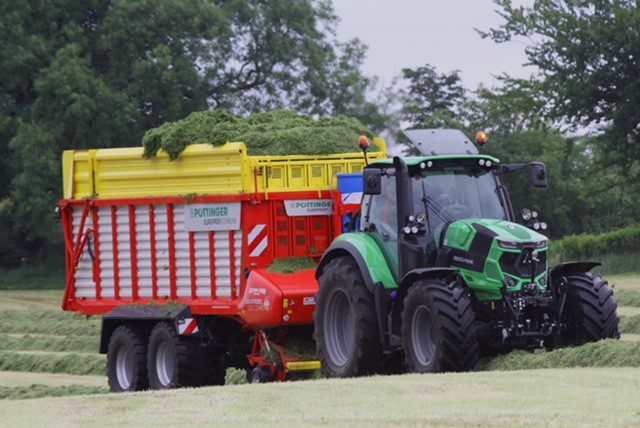Farming in Co. Derry, John Killen milks a herd of 200 high-yielding, crossbred cows under an autumn-calving system.
As calving kicks into gear in October, the farm has a large requirement for silage; between first, second and third cut some 350-400ac of silage are harvested each year.
Silage quality plays a crucial role on the farm, as many of the cows in the herd reach peak yield while housed over the winter months.
Given the farm’s location, the grazing year doesn’t begin until near the end of March and the use of silage as a buffer feed plays an important role during the summer months.
Next year, John hopes to harvest 500ac of silage to ensure that his pits are full for the following winter. All of this silage will be picked up with his trusted Pottinger Torro 5100 wagon.
Why a Pottinger wagon?
The Derry-based farmer has been using the Pottinger wagon for the past six years. Previously, the silage had been picked up using a trailed harvester before moving to the self-propelled route.
Despite having close family ties with a successful contracting business which utilises a self-propelled harvester, John felt that “the grass was being overly processed”.
He explained: “I didn’t like the fine chop produced by the harvester and, to be honest, I didn’t think the wagon was going to be much good. But, I was wrong.
I am very impressed with the silage produced by the wagon and it’s not overly processed. Before, with the self-propelled harvest, you could actually feel the sugar on the grass as it was being put into the pit.
“However, this isn’t the case with the wagon. With the Pottinger, the grass isn’t sticky and those sugars are being saved and utilised by the cows.
“Yes, it does take that bit longer to complete, but it’s worth it when it comes to the silage that’s produced.
On the workload, he said: “With four tractors – one to mow, one to ted, one to draw and one to roll the pit – it’s a doddle.
“With three tractors, it’s manageable. With the self-propelled harvester, you’d need a fleet of tractors just to draw the crop in from the fields,” he said.
A focus on quality
Given the significant acreage harvested, it may be quicker to harvest all of the silage at once using a self-propelled harvester.
However, John stressed that it’s all about quality when it comes to producing silage on his farm.
“The wagon has focused my mind on quality. There’s no point in drawing in larger loads of poor-quality grass.
“I aim to mow grass when it’s at its best and to get top-quality feed into my pits. With the wagon, we’re able to harvest whenever the grass is ready and, as a result, we’re maximising the quality in our silage pits.”
With the Pottinger Torro 5100 wagon, John chops the grass to a length of 35-40mm. This, he said, means the grass is less damaged and it’s easier to maintain the feed face of the pit at feed-out.
Fuel consumption
John uses a New Holland T7.210 ‘Auto Command’ to draw the Pottinger wagon on his farm. On fuel consumption, he said: “The wagon saves a fortune on diesel.”
On a short draw (0.75 miles), he said, the wagon is capable of bringing in 60-70ac of grass per day. This is achieved at a fuel consumption of 5L/ac.
“The wagon is well able to pack in grass when it’s dry and we can do up to 50 loads per day if the draw wasn’t too far. The pressure doesn’t really come on the tractor until the wagon is nearly full of grass.”
He added: “We have ground 1.5 miles away with a hill climb and the wagon can bring in three loads per hour from that ground and it uses 9L/ac.”
John also has another holding six miles away from the parlour. With the road haulage, 11-12L/ac of diesel are used to draw in grass from this land and two loads per hour are achieved.
The cows and production
John milks a herd of 200 three-way cross cows (Holstein Friesian, Fleckvieh and Norwegian Red). This year, on average, the cows in the herd produced 8,200L of milk at 4% fat and 3.28% butterfat.
He has noticed considerable herd improvements since making the switch to wagon silage – especially in terms of cow health.
“I’ve noticed that the cows have fuller rumens. Overall, the quality of the silage and the health of the cows has improved.”
Although John had very few cases of LDAs (left displaced abomasums) prior to making the switch to the wagon, no cases have been recorded since the wagon was purchased.
In addition, only a couple of cows each year suffer from ketosis following calving. This comes as there is more structural integrity to the diets being offered to the cows.
More information
Pottinger is currently offering 0% and low-interest offers on all grassland and tillage equipment. Tailored finance plans to suit any farm’s cash-flow are also available. Click here for more information





